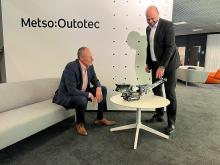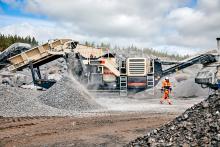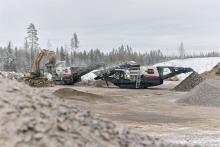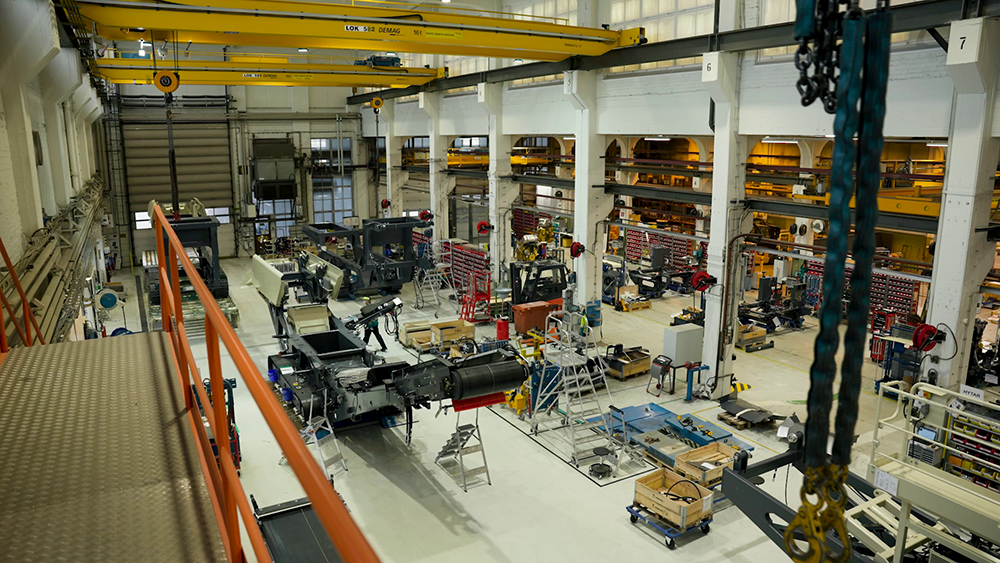
The results of a €20mn primarily Tampere facility-based investment in research and development (R&D), Metso’s new fully-electric crushers and screeners for aggregates and recycling customers are set to become highly sought-after solutions among premium plant customers upon their release, with the first models in the range set to come onto the market later this year.
Speaking during Aggregates Business’s visit to Metso Tampere in November 2022, Jarmo Vuorenpää highlights how the all-new, fully-electric Lokotrack EC range machines are based on Metso’s new electric platform and can be run from an integrated genset or external grid to lower operational cost.

Vuorenpää, director of the new Lokotrack offering, says the new machines are reliable plants that are easy to use, maintain and combine, and represent scalable solutions that are easily adaptable for different capacities and applications.
Lokotrack crushers and screeners were first launched onto the global market in 1985, but Vuorenpää stresses that the new fully-electric model range has been a case of “starting from scratch”.
“It has been our biggest-ever product range-based [Aggregates division] investment,” he emphasises. “We have been building our electric platform since 2020. It allows us to have scalable solutions for different capacities and applications. I don’t think anyone else in our industry is doing it this way.
“There are two main reasons for our approach. The first is the short-to-medium-term advantage of having a plant range with fewer parts and harmonised design. Our partners, distributors, and customers will get the same building blocks for each machine. The other advantage is that our modular electric platform will allow us to react much quicker when hydrogen fuel cells and other power technology options become available. We will be able to accommodate them far more easily.
“As well as extensive testing by Finnish customers of the first new Lokotrack plants, we are doing parallel technology testing. The latter testing is not related to the first few new Lokotrack launches but is preparing us for the future.”
“The new range has improved automation and connectivity among its new features. Our performance and plant-servicing baseline is pretty high, and we believe we can lift it still further,” adds Kimmo Vesamäki, vice president of technology and aggregates site manager at Tampere.
The new Lokotrack range will be fully compatible with the Metso Metrics (Metrics) online digital monitoring and data analysis solution. As well as increasing plant uptime by optimising maintenance scheduling and EPS (equipment protection services) inspections, Metrics enables users to carry out remote and self-service troubleshooting, and, in partnership with their dealer distributors and Metso, to measure, analyse and improve plant capacity and performance and achieve productivity (KPIs). MO Metrics also delivers big sustainability gains to customers globally via higher efficiency, production, yield, and plant utilisation while ensuring less idling, energy, wear, and waste. This, along with electric-power usage, dramatically lowers operators’ CO2 per tonne.
“We are trying to have all our equipment connected to Metrics on leaving the factory. There are a lot of people in our business who say, ‘I think so,’ when it comes to aspects of their plant’s operation, but we want to definitely know and have information that can improve things. Metrics supplies this and is its basic philosophy,” explains Pekka Itävuo, Metso digital development manager. “We have three types of Metrics users: the sales, distributors and customers, who have slightly different needs, and we need to be aware of this in supporting them.”
Tuomas Martinkallio, Metso vice president of digital services, says the evolution of Metrics will eventually see it extended, with the help of AI (artificial intelligence), to give the user more live, automated, actionable data analytics across multiple Metso crushers and screeners on a single job site.
The manufacturing of crushers at the 117-hectare Metso Tampere site started more than 100 years ago, in 1921. The very first four Blake No.2 model crushers were delivered to the Finnish Roads and Waterways Administration in 1921, and they were the first machines suitable for producing aggregates needed in road building.
By 1949, these initial machine ranges had gained considerable success, and a new jaw crusher that operated with a single toggle plate was launched. Research and development around rock crushing continued, and in 1976 the new C Series jaw crusher was launched.
The current Metso business was still part of Rauma-Repola in the 1980s, and the Tampere factory – then called Lokomo – became the world’s largest crusher manufacturer in 1989. This milestone was made possible after the acquisition of Ateliers Bergeaud’s operations in France, followed by Nordberg’s US functions a year later. As a result of this expansion, the manufacturing of crushers doubled in Tampere. Even though the company had already manufactured the Blake model, a predecessor of a mobile crusher in the 1920s, the launch of the iconic mobile crushing and screening plant Lokotrack in 1985 has turned out to be a true success story.

Metso ’s Tampere facility has produced thousands of crushers. The company hosts a 2008-established crushing test laboratory in Tampere, where customers’ rock samples are analysed, and then the best possible combination of machines to meet the customer requirements can be recommended. Ville Viberg, the Tampere facility engineering and testing manager, tells Aggregates Business how he needs a minimum of 5kg of customer site material to carry out standard or advanced tests, with around 300 tests a year carried out onsite. There is an average five-day turnaround in site material being received to the customer getting a detailed laboratory test report.
“For standard tests, we check the customer material’s solid density, crushability, and abrasiveness. The latter gives an indication of a crusher’s wear parts,” highlights Viberg. “In our advanced tests, we put the material through our lab jaw crusher, which is a smaller version of a Metso jaw crusher, with sensors measuring the crushing force, capacity, and power draw during operation. We can assess the product curve and how it compares to other tested products, detect problems with the final product shape and may recommend an alternative crusher for this type of material.”
Assisting Viberg in his work is Bruno, Metso’s intuitive software program for simulating the aggregates production process. First launched in 1996 and developed over time, Bruno covers all Metso feeders, crushers and screens. The user enters basic feed material and machinery data into the process, and the software predicts how the process will perform. The user can then determine the optimal process for each specific need.
As well as being responsible for assembling the new fully-electric and current Lokotrack plant ranges, Metso’s 900-plus-employee Tampere site remains the home of C Series jaw crusher and GP series cone crusher manufacturing. C Series plants are used in the primary crushing of excavated rock and ore. GP Series units are used in secondary, tertiary and fine crushing to manufacture rail ballast, cement and asphalt grades, and manufactured sand.
On our tour of the Lokotrack assembly lines led by manufacturing manager Annukka Tyynelä, Aggregates Business learnt how 60 people are involved in the assembly of the 60-tonne-plus plants. Assembly is carried out on stationary workstations, with workers working a single 7- or 8-4pm shift, Monday to Friday. Lokotrack models assembled comprise the LT1110, LT220D, LT330D, LT120(E), LT130E, LT300HP, and LT300HPS. The lead time for these larger Lokotrack plants as of November 2022 was “weeks”.
Meanwhile, around 100 people are tasked with assembling the below-60-tonne-class Lokotrack plants. Most assembly line personnel work one of two shifts, with those working longer day shifts over a two-week period offered the Friday or evening shift off in the third week. The motor-line assembly employees work a single shift. Lokotrack models assembled on this line are the LT96(S), LT106(S), LT116(S), LT1213(S), LT200HP, LT200HPS, LT200HPX, LT220GP, and LT7150. It takes around seven-to-eight days to assemble each below-60-tonne-class machine, with the lead time as of November 2022 as little as just one week.
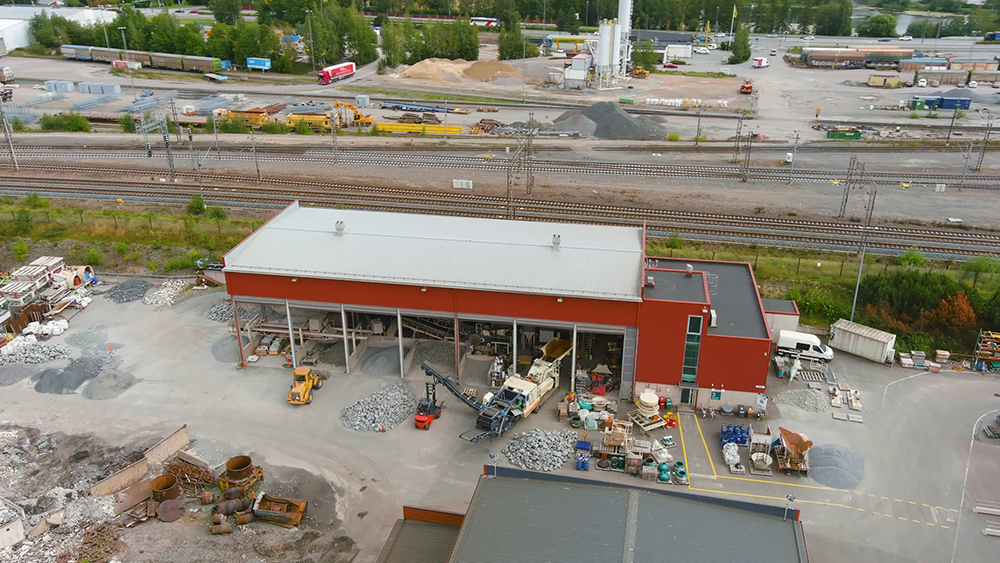
There are 1300 to 1900 pieces on each Lokotrack, with bigger plants tested in a dedicated outside area within the Tampere facility. Each Lokotrack plant has a 2,000-hour/12-month warranty.
Metso Tampere’s solar-panel-based power plant has 777 panels on the rooftop of the Lokotrack assembly hall. The electricity production is 180MWh/year, covering 10% of Lokotrack hall energy consumption. This year there is another solar-power plant being built on the rooftop of the main office building producing 103MWh/year and covering 25% of the office building’s energy consumption.
The Tampere facility is a ‘Tampere climate partner’: among Tampere regional businesses working with local authorities to deliver a greener environment for local communities. A ‘Less Final Painting’ project means that new paint for the Tampere manufactured and assembled plants dries faster and at room temperature, making the painting more energy efficient. There is LED lighting in assembly halls, with lights and heating only on in the assembly areas where people are working. Diesel forklifts have been replaced by electric forklifts.
The Tampere site’s strong green credentials provide a fitting link back to the imminent launch of the first models in Metso’s new fully-electric Lokotrack range. “Why this focus on electrification? Sustainability is, of course, a key focus of many of our customers,” says Kimmo Vesamäki. “Customers already benefit from existing Lokotracks’ lower dust and noise generation, and this will continue with the new electric range. In certain countries, you need to use electric-powered plants to get certain contracts. Electric-powered plants are also important from a lower operational cost perspective. We see great industry opportunities for the new electric Lokotrack range.”

